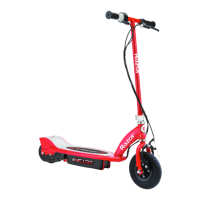Chargers have built-in overcharge protection to prevent batteries from being overcharged.
Note: If the charger gets warm during regular use, this is a normal response and is no cause for
concern. If your charger does not get warm during use, it does not mean that it is not working
properly.
Wall outlet – Green (stand by) Wall outlet and Unit – Red (Charging) Charging complete – Green
(Charged)
Note: Continue charging unit even if light turns green prior to 12 hours.
WARNING: Failure to recharge the battery at least once a the month may result in a battery that
will no longer accept a charge.
PRE-RIDE CHECKLIST
Brake
Check the brake for proper function. When you squeeze the brake lever, the brake should provide
positive braking action. Make sure that the brake is not rubbing when the lever is released.
Tire
Periodically inspect the tire for excess wear and replace as needed. Regularly check the tire
pressure and inflate as needed.
Frame, Fork and Handlebars
Check for cracks or broken connections. Although broken frames are rare, it is possible for an
aggressive rider to run into a curb or object and wreck, bend or break a frame. Get in the habit of
inspecting your scooter on a regular basis.
Hardware/Loose Parts
Before every ride, check all parts, such as nuts, bolts, cables, fasteners, etc., to ensure they are
secure and assembled correctly. There should not be any unusual rattles or sounds from loose
parts or broken components. If the unit is damaged, do not ride. Reference “Safety Warnings” on
page 1 of this manual.
Safety Gear
Always wear proper protective gear, such as an approved safety helmet. Elbow pads and
kneepads are recommended. Always wear athletic shoes (lace-up shoes with rubber soles) and
keep shoelaces tied and out of the way of the wheels, motor and drive system. NEVER RIDE
BAREFOOTED OR IN SANDALS.
Laws and Regulations
Always check and obey any local laws or regulations.
Insurance
Do not assume that your existing insurance policies necessarily provide coverage for scooter use.

